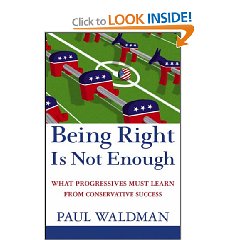
Useful High-End Book on Strategy for the Center-Left,
Page 111 is a very fine diagram of the issue columns that the Democratic Party simply does not address responsibly nor–a theme throughout the book–courageously. Over-all the book does a very fine job of defining the distinctions between conservatives and progressives, as well as the distinctions between what conservatives stand for and what they say, and what progressives stand for and do not say.
The author spends most of his time comparing conservatives to progressives (code for left of center liberals) which is something of a pity because he appears to have a very well developed sense of the issues and what the center and left-center can and should stand for.
There are two bottom lines in this book, and both of them make eminent sense to me:
1) Don't bring a knife to a gun-fight. The author points out in detail how inept and weak and unfocused the Democrats are at every stage of the political game beginning with high school and collage political clubs.
2) Stand for the public, for the individual taxpayer, for the blue-collar worker, the working poor, the lower middle class. The author stresses that this is a fight between those who respresent special interests and believe the government role is to liberate the marketplace (code for allow the looting of the Commonwealth) and those who should be representing the masses of individual workers and taxpayers.
The author takes a long view and believes that it will take a great deal of time to recover from the total abdication to the extremist Republicans. While this nice in principle, the book does not focus as well on what it will take to win over-whelmingly; for that we recommend Joe Klein's “Politics Lost.” On the issues, Matthew Miller's “The Two-Percent Solution.”
On a personal note, I would add that the author's focus on “Being Right is Not Enough” is perfectly consistent with my own view that “Vote Democratic Is Not Enough.” Rove and Cheney have demonstrated, twice, that they can steal Presidential elections that are close–through Florida in 2000, through Ohio is 2004. Even if every liberal-progressive adopted the ideas in this book, they would not be enough. We need a multi-party focus on electoral reform and crushing the extremist Republican thieves (I am a moderate Republican), crushing the special interests, and restoring the Republic to the public—a Republic of, by, and for the People, not Corporations.




